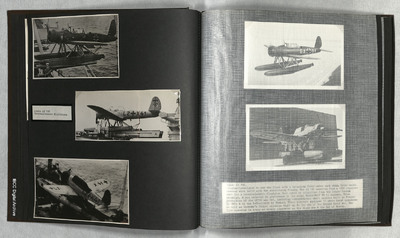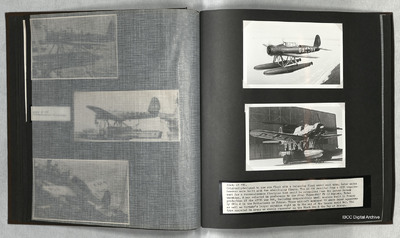Arado 196
Title
Arado 196
Description
Photo 1, 2 and 3 are an AR196 on a ship's launch ramp. Its primary role was maritime reconnaissance.
Photo 4 is a port side view of an AR196 flying over the coast.
Photo 5 is an AR196 on a trolley outside a hangar.
Photo 4 is a port side view of an AR196 flying over the coast.
Photo 5 is an AR196 on a trolley outside a hangar.
Language
Type
Format
Five b/w photographs on an album page
Publisher
Rights
This content is available under a CC BY-NC 4.0 International license (Creative Commons Attribution-NonCommercial 4.0). It has been published ‘as is’ and may contain inaccuracies or culturally inappropriate references that do not necessarily reflect the official policy or position of the University of Lincoln or the International Bomber Command Centre. For more information, visit https://creativecommons.org/licenses/by-nc/4.0/ and https://ibccdigitalarchive.lincoln.ac.uk/omeka/legal.
Identifier
PThomasAF20060009,
PThomasAF20060010
PThomasAF20060010
Transcription
[Photograph]
Arado AR 196
Reconnaissance Floatplane
[Photograph]
[Photograph]
[Page break]
[Photograph]
[Photograph]
Arado AR 196.
Originally designed to use one float with a balancing float under each wing. Later marks however were built with two stabilising floats. The AR 196 resulted from a 1936 requirement for a reconnaissance floatplae [sic] that could be catapulted from the larger German warships, & was selected in preference to the rival Focke-Wulf FW 62 biplane. Total production of the AR196 was 546, including comparatively small numbers built in France by SNCA & in the Netherlands by Fokker. These aircraft equipped 10 shore based squadrons as well as Germany’s larger warships right up to the end of the Second World War. The type operated in areas as widely separated as the Black Sea & the Bay of Biscay.
Arado AR 196
Reconnaissance Floatplane
[Photograph]
[Photograph]
[Page break]
[Photograph]
[Photograph]
Arado AR 196.
Originally designed to use one float with a balancing float under each wing. Later marks however were built with two stabilising floats. The AR 196 resulted from a 1936 requirement for a reconnaissance floatplae [sic] that could be catapulted from the larger German warships, & was selected in preference to the rival Focke-Wulf FW 62 biplane. Total production of the AR196 was 546, including comparatively small numbers built in France by SNCA & in the Netherlands by Fokker. These aircraft equipped 10 shore based squadrons as well as Germany’s larger warships right up to the end of the Second World War. The type operated in areas as widely separated as the Black Sea & the Bay of Biscay.
Collection
Citation
“Arado 196,” IBCC Digital Archive, accessed July 27, 2024, https://ibccdigitalarchive.lincoln.ac.uk/omeka/collections/document/23130.
Item Relations
This item has no relations.


